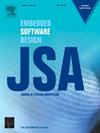Analysis and optimization of communication delay in multi-subscriber environments of ROS 2
IF 4.1
2区 计算机科学
Q1 COMPUTER SCIENCE, HARDWARE & ARCHITECTURE
引用次数: 0
Abstract
ROS 2 is one of the most popular robotic software development frameworks. ROS 2 employs a publish–subscribe paradigm for data exchanges, which can effectively address the diverse real-time requirements from the publisher side by various policies provided in the underlying communication layer. However, it remains unclear whether it adequately meets the various real-time requirements of subscribers. In this paper, we formally analyze the communication delay where a single message is published to multiple subscribers. In particular, we have identified a problem in the transmission of a message to multiple subscribers, where a subscriber with the highest priority may receive its message as late as the subscriber with the lowest priority. We propose policies to solve this problem and optimize the communication delay. Comprehensive experiments are conducted to validate and evaluate the proposed methods.
ROS 2多用户环境下通信延迟分析与优化
ROS 2是最流行的机器人软件开发框架之一。ROS 2采用发布-订阅范式进行数据交换,它可以通过底层通信层提供的各种策略有效地解决发布者端的各种实时需求。然而,它是否能充分满足用户的各种实时需求,目前还不清楚。在本文中,我们正式分析了一条消息发布给多个订阅者时的通信延迟。特别是,我们已经确定了向多个订阅者传输消息中的一个问题,其中具有最高优先级的订阅者可能会与具有最低优先级的订阅者一样晚收到其消息。我们提出了解决这一问题的策略,并优化了通信延迟。进行了全面的实验来验证和评估所提出的方法。
本文章由计算机程序翻译,如有差异,请以英文原文为准。
求助全文
约1分钟内获得全文
求助全文
来源期刊

Journal of Systems Architecture
工程技术-计算机:硬件
CiteScore
8.70
自引率
15.60%
发文量
226
审稿时长
46 days
期刊介绍:
The Journal of Systems Architecture: Embedded Software Design (JSA) is a journal covering all design and architectural aspects related to embedded systems and software. It ranges from the microarchitecture level via the system software level up to the application-specific architecture level. Aspects such as real-time systems, operating systems, FPGA programming, programming languages, communications (limited to analysis and the software stack), mobile systems, parallel and distributed architectures as well as additional subjects in the computer and system architecture area will fall within the scope of this journal. Technology will not be a main focus, but its use and relevance to particular designs will be. Case studies are welcome but must contribute more than just a design for a particular piece of software.
Design automation of such systems including methodologies, techniques and tools for their design as well as novel designs of software components fall within the scope of this journal. Novel applications that use embedded systems are also central in this journal. While hardware is not a part of this journal hardware/software co-design methods that consider interplay between software and hardware components with and emphasis on software are also relevant here.
 求助内容:
求助内容: 应助结果提醒方式:
应助结果提醒方式:


